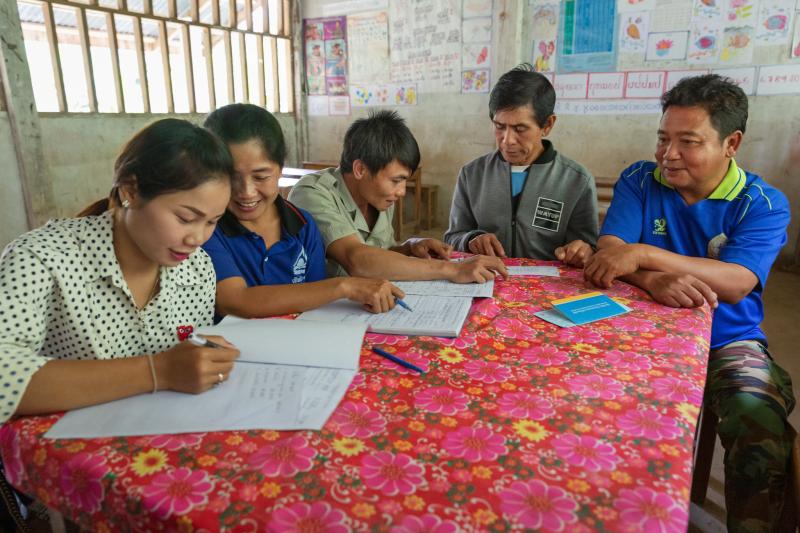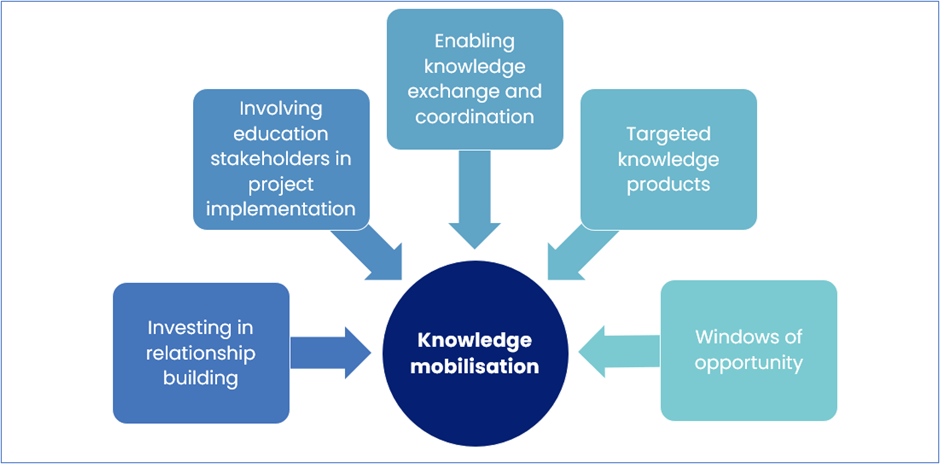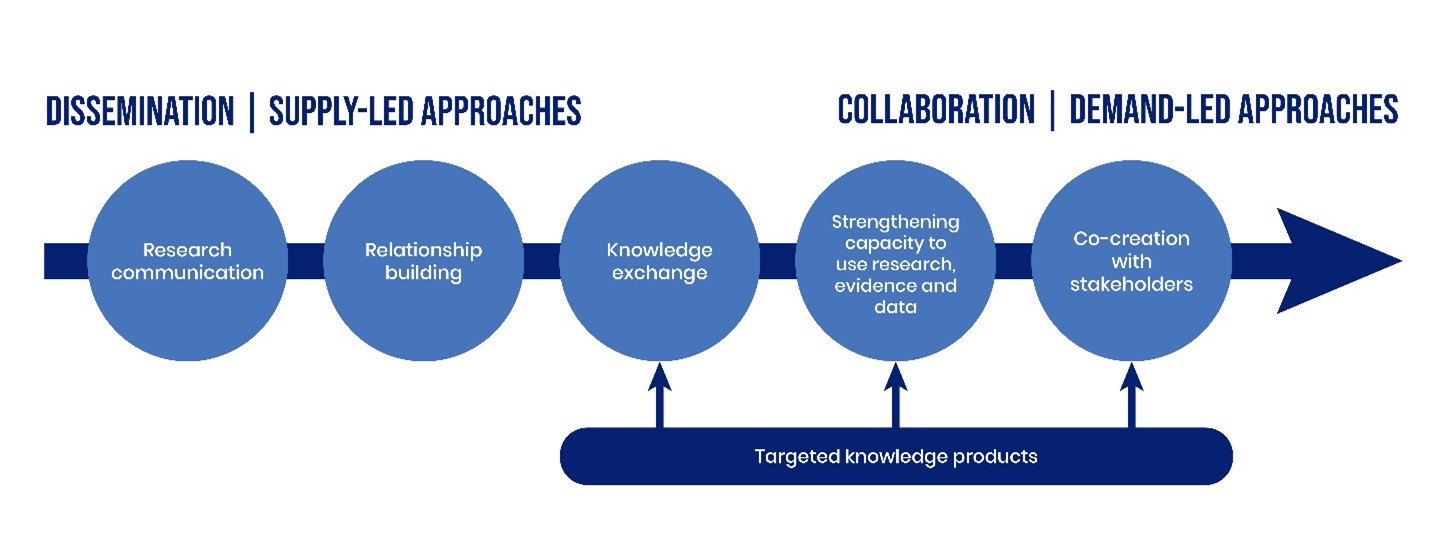
Effective knowledge mobilization is a necessary component of high-quality research for development (IDRC, 2022). It enhances the probability that relevant stakeholders will put research into use, thereby strengthening its impact on policy, practice and targeted populations. There are many different frameworks and approaches to knowledge mobilization in the Global South (Carden, 2009; Georgalakis, 2022; Mendizabal, 2022). Yet it is not always clear how knowledge mobilization is implemented in practice, what it involves at different stages of applied research projects, and what types of results can be expected at each stage.
This blog post sheds light on the topic through an analysis of the monitoring data of applied research projects that are part of the Global Partnership for Education (GPE) Knowledge and Innovation Exchange (KIX), a joint endeavour with Canada’s International Development Research Centre (IDRC). These projects conduct research in support of scaling the impact of innovations to address the education priorities of low- and lower-middle income countries.
Overall, monitoring data shows that five key knowledge mobilisation strategies have contributed to projects’ results, which in this case means either an initial endorsement of project activities or the uptake of research evidence or innovation by relevant stakeholders. These strategies include investing in relationship building at the start of research and throughout its implementation; involving relevant stakeholders in project implementation; enabling knowledge exchange and coordination among stakeholders; developing knowledge products tailored to the needs of stakeholders; and using windows of opportunities such as education sector planning, reform processes, and the COVID-19 pandemic to facilitate the uptake of research evidence and innovation.

From supply-led to demand-led knowledge mobilization activities
Monitoring data reveals that the knowledge mobilization activities of KIX applied research projects fall into six broad categories: research communications; relationship building; knowledge exchange; strengthening capacity to use research, evidence and data; co-creation with stakeholders; and the development of targeted knowledge products. It also showed that in many projects there is a general progression from dissemination and supply-led activities towards more collaborative and demand-led activities during the project cycle.

Activities on the supply-led end of the spectrum can be categorized as research communications. These include hosting events to present the objectives, design or results of research projects, or participating at events such as a roundtables or conferences organized by another group. These tend to be one-off events where communication predominantly flows in one direction, from the researchers to relevant project stakeholders or a wider audience. These activities can take place at different stages of the project. While initial events focus on presenting research objectives and design with the aim of securing a project, later events often focus on sharing preliminary and final results.
Next on the spectrum are activities aimed at relationship building. While these tend to occur earlier in the project cycle than research communication activities, they involve more collaborative engagement with stakeholders. They may include introducing or launching research with national or local stakeholders, exploring opportunities for collaboration, and planning research activities with relevant stakeholders. Before engaging in relationship building, many projects conduct stakeholder mapping. As projects progress, some may need to re-establish relationships because of education leadership changes, a lack of engagement from originally identified stakeholders, or the emergence of newly-identified relevant stakeholders.
The next category is knowledge exchange, which enables multi-stakeholder discussion and collaboration through roundtable events, communities of practice, or technical working groups. Projects usually organize multi-stakeholder roundtables to present and exchange ideas and solicit feedback on research design, adapting innovations to new contexts, or on the analysis of collected data or draft outputs. In contrast to roundtable events, communities of practice and technical working groups engage participants on an ongoing basis; they are usually established at the start of the project, and they tend to include senior education officials who act as project champions. Their purpose is to offer a space for diverse stakeholders to exchange perspectives and knowledge, contextualize findings, and create a sense of ownership over the research. Knowledge exchange also includes validating preliminary or final findings with groups of participants or potential research users.
Demand-led and collaborative activities include strengthening capacities to use research and innovation and co-creating research and policy with counterparts. Capacity strengthening involves organizing activities to enhance the knowledge and ability of individuals to apply research evidence in education processes such as education sector planning or to integrate an innovation into an education system. Projects deliver capacity strengthening activities as part of their original design or in response to demands from relevant education stakeholders. Co-creation entails researchers and relevant project stakeholders working side-by-side on the research design, the collection and analysis of data, and the use of findings to inform policy and practice. Co-creation may also include working together with relevant stakeholders to adapt and contextualize an innovation.
The development of targeted knowledge products spans across knowledge exchange, strengthening capacities to use research, evidence and data, and the co-creation of research and policy with counterparts. These products can include tailored information about project activities and innovations in response to requests from relevant project stakeholders, or guides and tools to facilitate stakeholders’ capacity strengthening. They can also include outputs with evidence that addresses specific stakeholder needs such as education policy challenges. These outputs are often co-developed in close consultation with the stakeholders.
From research endorsement to evidence and innovation uptake
The above activities have contributed to a wide range of immediate and substantive results. Immediate results include national education stakeholders, local governments, or implementing agencies endorsing projects and their activities. Most projects were able to secure these results at the start of their activities following research communications and relationship building activities: education authorities often expressed their support for the project, showing their enthusiasm for using findings and innovation in the future and their support for undertaking research activities.
More substantive results include education stakeholders putting key issues on the agenda for further deliberation or introducing and developing new policies drawing on research findings. They also include governments or implementing agencies committing to scale innovations following their successful piloting or making changes to education programs and processes based on evidence and recommendations. These results typically came at later stages, once projects have generated findings. However, findings alone do not contribute to results, which are achieved through a combination of findings, knowledge mobilization activities, and windows of opportunity.
The experiences of KIX applied research projects demonstrate that knowledge mobilization is a complex process. It takes various shapes and forms and has distinct results at different stages of the project. These projects have also shown that there is no silver bullet to knowledge mobilization. Effectively positioning research for use in education policy and practice requires a combination of different strategies, employed through dynamic and adaptive approaches at each stage of the research.
Along with this analysis of the monitoring data, blogs in this series detail the knowledge mobilization experiences of individual projects and shed further light on how it looks in practice and what it involves at different project stages. We learn about scaling advisory committees from CAMFED; stakeholder mapping and knowledge mobilization processes at community and national levels from World Vision; action research with project participants as a form of co-creation from the University of Oslo, and multi-stakeholder knowledge mobilization from the Tata Institute of Social Sciences.
